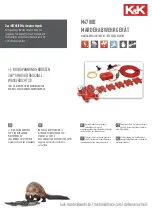
SLUU150 – February 2003
13
Evaluation Modules for Simple –48-V Hot Swap Controllers
4.3
Changing the Current Limit Threshold
During power-up of a plug-in card, the TPS2390 and TPS2391 limit the peak inrush current
drawn by the discharged bulk capacitance. The LCA senses load current as the drop across an
external sense resistor. Current is regulated by slewing the gate of the pass FET to maintain the
voltage drop at an internally set level, nominally 40 mV. Therefore, the peak current level can be
established by selecting the appropriate sense resistor value. On the –48-V hot swap EVM, this
resistor is R4. The default value of R4 is 20 m
Ω
. To modify the current limit threshold, a new
sense resistor value can be determined from Equation 1.
R4
v
V
MAX
I
MAX
where
•
V
MAX
is the sense voltage limit
•
I
MAX
is the desired current limit threshold
Using the device minimum value of 33 mV for V
MAX
along with the required minimum load
current ensures that minimum amount of current can always be supplied to the load. For
example, a particular line card is expected to draw a maximum of 1.2 A, when the power bus is
at its operating minimum level of –36 V, once the card is powered up and operating normally. For
this load characteristic, a sense resistor value less than 33 mV/1.2 A, or 27 m
Ω
, is selected. A
25-m
Ω
resistor is the closest approximate standard value that is readily available. A
smaller-value resistor is also adequate, but carries a corresponding increase in the maximum
current limit.
4.4
Changing the Inrush Slew Rate
The TPS2390 and TPS2391 also feature slew rate limiting as current is ramped to charge the
load capacitance. The slew rate is easily programmed, once the sense resistor is determined,
with a small-value capacitor connected between the IRAMP and –VIN pins. The EVM comes
equipped with three preset capacitor values, selectable either individually or combined by
closing the appropriate DIP switches of SW1. The default values of the capacitors, and the
corresponding nominal slew rates, are given in Table 5.
Table 5. Default Slew Rates
SW1 DIP
REFERENCE
DESIGNATOR
INSTALLED
VALUE
SLEW RATE
(A/s)
1
C1
1000 pF
5000
2
C2
0.01
µ
F
500
3
C3
0.047
µ
F
106
The EVM can be used to illustrate the relationship between current limit, inrush slew rate, load
values, and the circuit’s fault timing requirements. With only DIP switch SW1–1 closed, the
fastest of the preset slew rates is selected, and only the hard-wired timing capacitor C9 is
connected to the TPS2390 or TPS2391 controller. However, this is sufficient to allow the bulk
capacitor C6 to fully charge, from 0 volts, across the full range of input supply voltages, down to
–80 V. This can be observed by connecting input power as shown in Figure 3, displaying the
VOUT– node on an oscilloscope, and enabling the device.
(1)

































